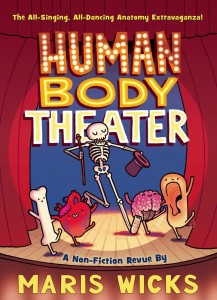Wrapping Up :01 Week
I was tempted to break with the pattern of :01 Books week here at Fleen, particularly since the prediction that I made eight days ago has come to pass, where Raina Telgemeier now holds fully half of the latest New York Times Best Seller List for paperback graphic novels. Suffice it to say that this domination of the graphic novel sales channel is unprecedented at the level of an entire company, much less a single creator. Whatever superlatives you feel best describe this situation, I assure you that I feel just as strongly. Everybody feel good for Raina!
But theme weeks are theme weeks, and so we’re going to spend the rest of today on Maris Wicks, who has a history in educomics — we saw her team up with Jim Ottaviani in 2013 to tell the stories of Jane Goodall, Dian Fossey, and Biruté Galdikas, and she spends her non-comics time as a program educator at the New England Aquarium. This time around, she’s tackling the marvel of science that defines us — the human body, from stem to stern, in the informative Human Body Theater.
Now let’s get something out of the way — some people are not going to like this book. It acknowledges the existence of things that they are uncomfortable with, things like sex, puberty, genitals, HIV, menstruation, erections, pee, poop, farts, and snot. It includes everything from primers on cell theory, atomic theory, and the nature of visible light, as well a thorough discussion of the major systems of the body and their functions. Some people are not going to want their kids (the book is easily acceptable for children 10 and up) to learn about how things work on the inside, preferring them to treat such matters as fit only for a sense of shame. Those kids are the ones that need this book most of all.
Because beyond the simple, factual discussion of things that provoke that shame reaction, Human Body Theater is a terrific guide to gross anatomy, how everything from the histamine reaction to the autonomic nervous system works, and how to keep it working properly. There’s nice asides about the importance of hygiene and nutrition, and in the chapter on sensory function, acknowledgment that not everybody gets to have a body in perfect working order and that’s okay.
For example, color blindness means that you have more trouble picking out matching clothes, actual blindness means you use assistive devices or animals, and deafness is countered with sign language. It’s a particularly nice touch that Wicks includes both Braille and ASL alphabets and plants the idea Yes, this is more challenging, but people adapt.
Along the way, Wicks demystifies all the stuff that your average 10 year old is probably entranced and grossed out by in equal measure: blood, farts, burps, snot, pee, and poop (this is looking a lot like that earlier shame list) all get attention that sends the message This happens to everybody; just be cool and be polite. Some of those kids may not yet be aware of things like erections, but they’re treated as matter-of-factly without getting overly explicit. The young reader is going to come away with the impression that bodies are weird, complicated, wonderful, with lots of cool stuff going on when you stop to think about it.
The older reader is going to learn as well — you may have forgotten (or never been taught) about the musculoskeletal, cardiopulumonary, digestive, excretory, endocrine, reproductive, immune, and neurological functions of the human body, and this book is as good an overview as I’ve seen. I’m thinking it belongs in middle-school health classes, and very possibly in the anatomy and physiology section of the EMT classes I teach¹.
Human Body Theater releases on 6 October, which is enough time to remember how to pronounce things like mitochondria and metatarsals. One last time, we at Fleen thank Gina Gagliano and everybody at :01 for the review copies
Spam of the day:
Hi fleen.com admin, i see you need some fresh content. Daily updates will rank your page in google higher, content is king nowadays.
Yes, because nearly 4800 words about six books in five days isn’t fresh content. Bozo.
_______________
¹ Heck, I know baby EMTs who can’t tell you about the three kinds of muscle, how they differ, and where they occur. It’s all here in a couple of full-color pages that makes everything clear and obvious; if HBT included a full discussion of terms like distal and proximal and the planes of the body, I’d make it mandatory reading for A&P.

The above comments are owned by whoever posted them. The staff of Fleen are not responsible for them in any way.